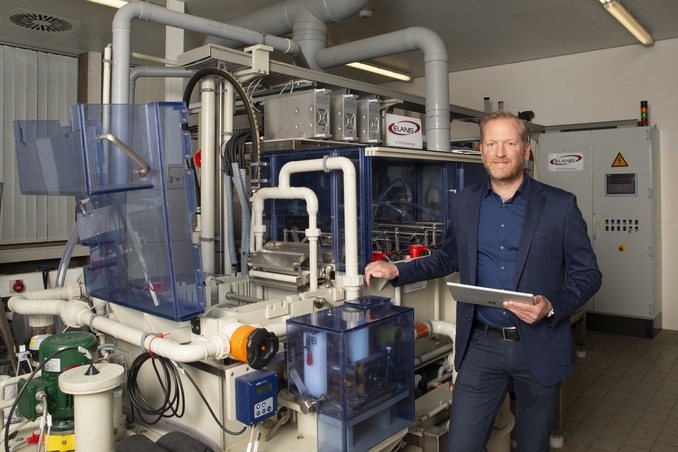Battery optimization drives the energy transitionResearch group at Aalen University researches improved battery components

Prof. Dr. Timo Sörgel an der weltweit ersten Technikumsanlage, an der durch eine von ihm entwickelte patentierte Verfahrenskombination Folienverbundmaterial hergestellt werden kann, beispielsweise für Batteriekathoden. Foto: © Hochschule Aalen | Foto: Volker Miosga
Smartphones, electric cars, wind turbines: there is hardly any area of life in which lithium-ion batteries are not used. The energy storage devices are versatile, have a high energy density, low self-discharge and long-lasting performance. If they could be improved in some aspects, the benefits would be enormous. Aalen University is researching processes that could enable the production of cost-effective, environmentally friendly and safe battery components.
The German government wants to see at least seven to ten million electric vehicles on Germany's roads by 2030. This is another reason why electromobility is to be massively expanded in Germany. The group led by Prof. Dr. Timo Sörgel from the Center for Electrochemical Surface Technology (ZEO) at Aalen University is researching processes that could enable the production of improved battery components that are cheaper, more environmentally friendly and safer. In terms of electric cars, this would mean faster charging times and higher performance. This would also increase the acceptance of electric vehicles among drivers. In addition, it would be much easier to recover the raw materials from the electrodes, making the batteries more sustainable and economical.
Better batteries promote electromobility
Sörgel has been working for around ten years on electroplating processes in which metals are deposited on a surface using an electric current. The aim is to optimize electrodes for lithium batteries: "The process we have developed is called composite electroforming. We combine dispersion deposition and foil electroforming to produce cathodes for lithium-sulphur and lithium-ion batteries." In classic foil electroforming, a rotating roller, for example made of titanium, is electroplated and the deposited metal layer is simultaneously and continuously removed from this roller in the form of a foil. During dispersion deposition, functional particles, in this case the cathode active materials, are incorporated into the electrodeposited metal matrix.
Hands-on mentality
"This combination of processes gives us a free-standing composite film that can be used directly as a finished battery cathode. We recently put the world's first pilot plant for this into operation here in Aalen," says the researcher proudly. This technology and the film composite material produced by his team have been patented in Germany, France and the UK since 2019. Many young students who are enthusiastic about the future technology of composite electroforming work in Sörgel's research group. The team also includes student Suvetha Logeswaran from the Surface Technology/New Materials course. In her Bachelor's thesis, she is investigating the compatibility between the electrodeposited metal matrix and the embedded functional particles during dispersion deposition as a function of surface and interface energies. "I came to surface technology through my chemistry degree. I love how innovative and current our topics are, for example battery technology." She particularly likes the hands-on mentality in the research group. Spontaneous ideas are implemented without further ado and when problems arise, for example with 3D printing or CAD designs, solutions are quickly found within the team. "In the research group, I realized how practical my studies at Aalen University were. I was able to practically apply knowledge from the lectures here in the lab," says Logeswaran.
Putting battery technology into practice
Phillip Scherzl, who completed a dual study program supported by SCHOTT at Aalen University, also gained a lot of practical experience. In the "Advanced Materials and Manufacturing" research master's program at Aalen University, he was able to combine the areas that particularly interested him: electrochemistry, electroplating and battery technology. "In my thesis, I worked on fundamental issues in order to be able to later implement the composite electroforming of cathodes for lithium-ion batteries with aluminum as a matrix metal." This led to the development of a defined structured current collector made of aluminum for batteries - important results that contributed significantly to a recently published scientific paper by the working group. After completing his studies, he joined the company as a Process Engineer Surface Technology: "As I worked very independently throughout my Master's degree and took on responsibility, this is now easy for me when I start my job."
Young researchers for the energy transition
Recruiting promising talent directly from universities who have already gained experience in relevant projects: This benefits companies that work closely with the scientific community. This is especially true for highly application-oriented and future-oriented areas such as battery research. This is because the global market for batteries is growing rapidly: according to a study by McKinsey, demand will increase by 30 percent annually until 2030. At the same time, raw materials for production will become scarce in the long term - new generations of batteries that do not require rare earths and can be recycled efficiently are therefore urgently needed. "The training of experts in the battery sector, as it works in cooperation between scientific institutions and companies, is therefore an essential building block for the success of the energy transition," emphasizes Sörgel.
